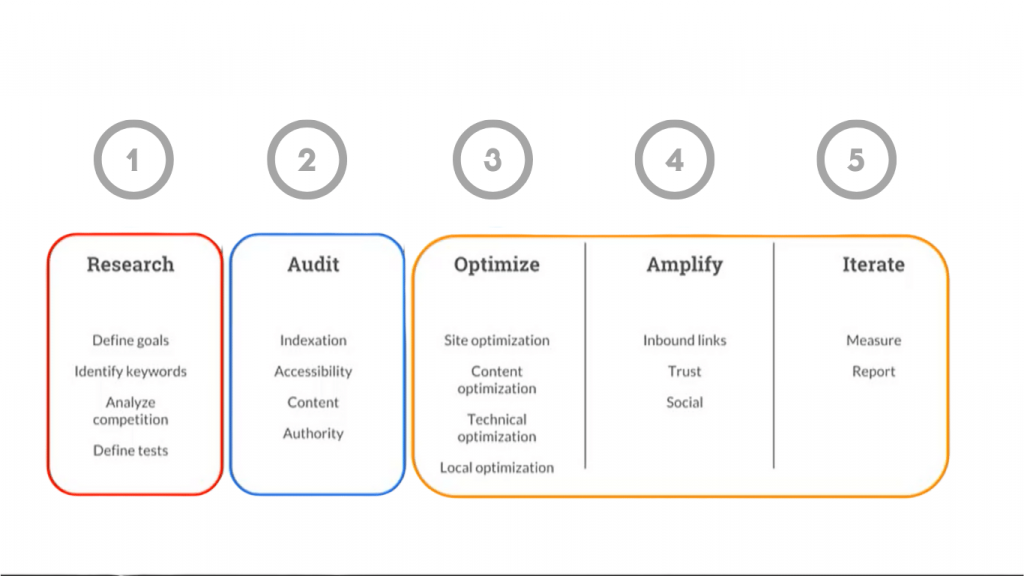In this article we’re going to talk about SERPs in search intent. We’re going to ask what is a SERP.
You’re going to see this term used commonly in blogs and in discussions about SEO.
Let’s go ahead and define it and make sure you feel comfortable with what is a SERP? Then we’re going to look at these SERPs and define amongst them the three types of search intent.
Search intent is an interesting way of assessing what we see within search engine result pages. And so we’re going to go over the top three types.
Then we’ll discuss briefly branded search intent. It’s not one of the typical three types that are mentioned often in SEO, however, we’ll call out branded search intent specifically, and talk about the implications there.
SEO Methodology in SERPs
In this Section, let’s discuss about SEO methodology for search engine results pages.
That is a process that you can use when implementing SEO generically for any site. It really consists of these following steps.

Research
Usually, you’re going to begin with a Research Phase where if you’re working with a client, or internally, you’re going to define goals, that is, what are we trying to accomplish.
What pages do we want to see more traffic? And what kind of conversions do we want to have, you’ll also investigate different keywords based upon your personas, or the different portions of the sales funnel that you might target.
There’s often some competitive analysis that takes place here. And then because SEO like most digital marketing activities, is a iterative process, you’ll define some of the tests you want to run.
So for example, let’s see if we change something on our site, does it improve against the goal that we’ve defined, right?
So, you want to define those goals, and then define the tests that are going to help prove out those goals?
Another way to look at this methodology is to say, in step one, we’re really defining the competitive landscape, right? We’re talking to our internal stakeholders or our clients in defining the competitive landscape.
Site Audit
The next phase, once you have that is to do a very comprehensive Site Audit.
So, in this case, you would be looking at inhibitions to whether or not you’re indexed?
Or is your site accessible?
What is your content like and do some analysis of the authoritativeness of your links in your link building process.
So, research first, and then do a Site Audit, oftentimes, these two steps could be conflated and done at the same time.
But nonetheless, there’s a first step and the second step, later, once you have done your keyword research, and you’ve audited your site for the different types of issues that may have, then you want to move into your optimization.
Optimization
Now, oftentimes, with people doing search engine optimization, they will start at step three, they’ll say, let’s start changing page titles, let’s start changing meta descriptions, let’s get more links.
And they haven’t done the necessary research and audit steps to really make the most of these optimization phases.
So this includes things like is our content optimized?
Can we do technical optimizations, all different variety of things in there, and again, those relate to some of the tests that you want to run.
Once you’ve done and optimize some of your pages, then you can move into the amplification phase.
Amplification
That is, let’s get links to these pages that we’ve we’ve optimized.
So doing backlink analysis, identifying different sources for links, things like that using social media to get the word out about different pages that you want to see if you can improve the conversions or traffic to.
Iteration
And then you want to very importantly, use this fifth step, which is measure what you’ve done against the test that you define and report on it say, hey, how have we done or the things that we’re doing measurable?
Have they had the desired impact? If it looks like it hasn’t had the desired impact?
That’s fine sometimes. Learning means that you sometimes are successful, sometimes you’re unsuccessful, but you want to make sure that you establish good goals, and define those tests in the beginning, so you can measure and report against them.
Another way to look at this methodology is to say, in step one, we’re really defining the competitive landscape, right? We’re talking to our internal stakeholders or our clients in defining the competitive landscape, then we want to do a Site Audit and identify what are our strengths and weaknesses within that competitive landscape? Where are we strong? Where are we weak, what are things that we can change, and then there’s a number of implementation phases.
So again, oftentimes people will start Search Engine Optimization activities at step three, when they haven’t done the appropriate research and audit phases.
So just when you’re doing SEO, realize that you’re probably going to have to move things to the left a little bit and make sure you’re defining goals, and doing a lot of research prior to ever changing things on the site. It will really be helpful.
